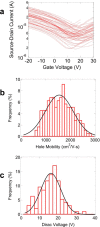Scalable production of highly sensitive nanosensors based on graphene functionalized with a designed G protein-coupled receptor
- PMID: 24742304
- PMCID: PMC4025580
- DOI: 10.1021/nl5006349
Scalable production of highly sensitive nanosensors based on graphene functionalized with a designed G protein-coupled receptor
Abstract
We have developed a novel, all-electronic biosensor for opioids that consists of an engineered μ-opioid receptor protein, with high binding affinity for opioids, chemically bonded to a graphene field-effect transistor to read out ligand binding. A variant of the receptor protein that provided chemical recognition was computationally redesigned to enhance its solubility and stability in an aqueous environment. A shadow mask process was developed to fabricate arrays of hundreds of graphene transistors with average mobility of ∼1500 cm(2) V(-1) s(-1) and yield exceeding 98%. The biosensor exhibits high sensitivity and selectivity for the target naltrexone, an opioid receptor antagonist, with a detection limit of 10 pg/mL.
Figures




Similar articles
-
Scalable Production of Molybdenum Disulfide Based Biosensors.ACS Nano. 2016 Jun 28;10(6):6173-9. doi: 10.1021/acsnano.6b02137. Epub 2016 Jun 15. ACS Nano. 2016. PMID: 27227361 Free PMC article.
-
All-Electronic Quantification of Neuropeptide-Receptor Interaction Using a Bias-Free Functionalized Graphene Microelectrode.ACS Nano. 2018 May 22;12(5):4218-4223. doi: 10.1021/acsnano.7b07474. Epub 2018 Apr 17. ACS Nano. 2018. PMID: 29634231 Free PMC article.
-
Scalable Arrays of Chemical Vapor Sensors Based on DNA-Decorated Graphene.Methods Mol Biol. 2019;2027:163-170. doi: 10.1007/978-1-4939-9616-2_13. Methods Mol Biol. 2019. PMID: 31309480
-
Printed organo-functionalized graphene for biosensing applications.Biosens Bioelectron. 2017 Jan 15;87:7-17. doi: 10.1016/j.bios.2016.07.116. Epub 2016 Aug 1. Biosens Bioelectron. 2017. PMID: 27504792 Review.
-
Interactions of DNA with graphene and sensing applications of graphene field-effect transistor devices: a review.Anal Chim Acta. 2015 Jan 1;853:127-142. doi: 10.1016/j.aca.2014.10.023. Epub 2014 Oct 18. Anal Chim Acta. 2015. PMID: 25467454 Review.
Cited by
-
Scalable graphene sensor array for real-time toxins monitoring in flowing water.Nat Commun. 2023 Jul 13;14(1):4184. doi: 10.1038/s41467-023-39701-0. Nat Commun. 2023. PMID: 37443127 Free PMC article.
-
Dielectrophoresis-Enhanced Graphene Field-Effect Transistors for Nano-Analyte Sensing.ACS Appl Mater Interfaces. 2025 Jun 4;17(22):32764-32772. doi: 10.1021/acsami.4c22829. Epub 2025 May 22. ACS Appl Mater Interfaces. 2025. PMID: 40401923 Free PMC article.
-
Scalable biomimetic sensing system with membrane receptor dual-monolayer probe and graphene transistor arrays.Sci Adv. 2023 Jul 21;9(29):eadf1402. doi: 10.1126/sciadv.adf1402. Epub 2023 Jul 21. Sci Adv. 2023. PMID: 37478177 Free PMC article.
-
Detection of an IL-6 Biomarker Using a GFET Platform Developed with a Facile Organic Solvent-Free Aptamer Immobilization Approach.Sensors (Basel). 2021 Feb 13;21(4):1335. doi: 10.3390/s21041335. Sensors (Basel). 2021. PMID: 33668579 Free PMC article.
-
Nanosensors for diagnosis with optical, electric and mechanical transducers.RSC Adv. 2019 Feb 27;9(12):6793-6803. doi: 10.1039/c8ra10144b. eCollection 2019 Feb 22. RSC Adv. 2019. PMID: 35518460 Free PMC article. Review.
References
-
- Chung C.; Kim Y.-K.; Shin D.; Ryoo S.-R.; Hong B. H.; Min D.-H. Biomedical Applications of Graphene and Graphene Oxide. Acc. Chem. Res. 2013, 46, 2211–2224. - PubMed
-
- Kuila T.; Bose S.; Khanra P.; Mishra A. K.; Kim N. H.; Lee J. H. Recent Advances in Graphene-Based Biosensors. Biosens. Bioelectron. 2011, 26, 4637–4648. - PubMed
-
- Lee Y.; Bae S.; Jang H.; Jang S.; Zhu S.-E.; Sim S. H.; Song Y. I.; Hong B. H.; Ahn J.-H. Wafer-Scale Synthesis and Transfer of Graphene Films. Nano Lett. 2010, 10, 490–493. - PubMed
-
- Levendorf M. P.; Ruiz-Vargas C. S.; Garg S.; Park J. Transfer-Free Batch Fabrication of Single Layer Graphene Transistors. Nano Lett. 2009, 9, 4479–4483. - PubMed
Publication types
MeSH terms
Substances
Grants and funding
LinkOut - more resources
Full Text Sources
Other Literature Sources
Research Materials

